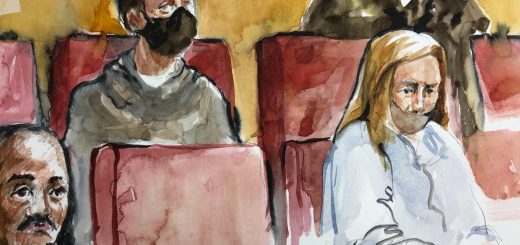Making Sense of Consequential Charter Breaches After R v Zacharias

In R v Zacharias, 2023 SCC 30 [Zacharias], a divided Supreme Court of Canada (“SCC” or the “Court”) held that evidence obtained through an unlawful detention cannot be used to ground a lawful arrest. Although Zacharias set a uniform national standard on this point, the SCC was anything but uniform in addressing the issue and its implications for s. 24(2) of the Canadian Charter of Rights and Freedoms (the “Charter”).
Background
On February 17, 2017, George Zacharias was pulled over by the RCMP while driving on Highway 1 near Banff, Alberta. Constable Tyler MacPhail initiated the traffic stop after observing that Zacharias’ truck had a burnt-out light and illegally tinted windows. During the traffic stop, Cst. MacPhail became suspicious of Zacharias, who appeared overly nervous. Cst. MacPhail observed a large quantity of luggage and a cover concealing the truck box’s contents. The amount of luggage appeared inconsistent with Zacharias’ statement that he was visiting his sister in Calgary for a few days.
Cst. MacPhail ran Zacharias’ name through police databases and discovered a complaint from 2014 implicating Zacharias in trafficking cocaine and marijuana. This information confirmed Cst. MacPhail in his suspicions, and he detained Zacharias before deploying a sniffer dog to inspect the truck. The sniffer dog indicated drugs were present, and Cst. MacPhail arrested Zacharias for possession of a controlled substance. Cst. MacPhail conducted a search incident to arrest and discovered 101.5 pounds of cannabis inside the truck. Zacharias was then re-arrested for possession for the purpose of trafficking, handcuffed and driven to the Banff police detachment.
Police continued to search the truck while Zacharias remained in police custody, discovering 126 edibles, 700 grams of cannabis oil and $12,600 stashed inside. Zacharias was arrested for a third time, this time for possession of proceeds of crime over $5,000. Zacharias would be released from police custody at 1:37 AM, six hours after arriving and seven hours after he was initially pulled over.
Procedural History
Alberta Court of King’s Bench
At trial, Marriott J. held that Cst. MacPhail lacked reasonable suspicion to detain Zacharias and order the sniffer dog search. Consequently, these steps violated Zacharias’ rights under ss. 8 and 9 of the Charter. Nonetheless, the trial judge concluded that the evidence should not be excluded under s. 24(2). Applying the test in R v Grant, 2009 SCC 32 [Grant], Marriott J. considered whether admitting the evidence would bring the administration of justice into disrepute, having regard to:
- (1) the seriousness of the Charter‑infringing state conduct;
- (2) the impact of the breach on the Charter‑protected interests of the accused; and
- (3) society’s interest in adjudicating the case on its merits (Grant, para 71).
The trial judge held that the seriousness of the police misconduct was at the low end of the spectrum, as Cst. MacPhail’s grounds to detain came close to the reasonable suspicion standard. Cst. MacPhail was neither reckless nor deliberate in failing to meet that standard, minimizing his misconduct’s seriousness. Further, the impact on Zacharias’ Charter-protected interests was low, as his reasonable expectation of privacy on a public highway was slight and the sniffer dog search was minimally invasive. Finally, society had a compelling interest in adjudicating the case on its merits, as the cannabis found in Zacharias’ truck was highly reliable, real evidence that was central to the Crown’s case.
As the first two factors only slightly favoured exclusion while the third strongly favoured admission, the trial judge admitted the cannabis evidence. Zacharias was subsequently convicted of possession for the purpose of trafficking under s. 5(2) of the Controlled Drugs and Substances Act, SC 1996, c 19.
Court of Appeal for Alberta
Zacharias appealed his conviction to the Court of Appeal for Alberta (“ABCA”). Among other grounds, Zacharias argued the trial judge had erred in her s. 24(2) analysis by failing to consider consequential breaches flowing from his unlawful detention and the impact of those breaches on his Charter-protected interests. Wakeling and Crighton JJ.A, writing as the ABCA majority, dismissed this ground of appeal on the basis that the trial judge was not required to consider the alleged consequential breaches, as Zacharias did not raise these arguments during the voir dire.
Khullar J.A. (as she then was) dissented on two points. First, she held that the evidentiary record was sufficient to consider Zacharias’ novel arguments on consequential Charter breaches. Further, Khullar J.A. agreed with Zacharias that the police had committed several consequential breaches of his s. 8 and 9 rights. As the evidence police obtained through the unlawful detention supplied the basis for Zacharias’ subsequent arrests, all further investigative steps were tainted by that breach and needed to be considered in assessing the impact on Zacharias’ Charter-protected interests. This included the truck search and the six hours he spent at the Banff police detachment. None of these incursions on Zacharias’ privacy and liberty interests would have occurred had Cst. MacPhail understood that he lacked lawful authority to detain Zacharias in the first place.
Conducting her own s. 24(2) analysis, Khullar J.A. found these subsequent investigative steps deepened the impact on Zacharias’ Charter-protected interests, tipping the balance in favour of exclusion. Zacharias subsequently appealed as of right to the SCC.
Triple Threat at the SCC
At the SCC, there was no dispute that the Court should consider the novel issues relating to consequential Charter breaches. The critical issue became the legal status of consequential breaches and their proper place, if any, within the s. 24(2) analysis—an issue which would split the Court into three camps.
Rowe and O’Bonsawin JJ.
Rowe and O’Bonsawin JJ. held that police cannot rely on unlawfully obtained evidence to ground a lawful arrest. If reasonable and probable grounds to arrest would not have existed without the unlawfully obtained evidence, then any subsequent arrest based on that evidence becomes unlawful. This approach is aimed at ensuring police are not incentivized to go on a “fishing expedition”, disregarding civil liberties with the knowledge that further investigative steps will be immune from Charter scrutiny.
Rowe and O’Bonsawin JJ. carve out a niche for consequential breaches, distinguishing them from independent Charter violations. Consequential breaches are unique insofar as a prior, initial breach renders them unlawful rather than the police conduct as such. In Zacharias, nothing indicated the arrests were conducted improperly. Rather, the arrests only became unlawful because Cst. MacPhail relied on evidence from an unlawful search in forming reasonable and probable grounds.
The manner in which Rowe and O’Bonsawin JJ. frame this distinction between consequential and independent breaches has pivotal consequences for the analysis under s. 24(2). In assessing the first Grant factor, the more severe the police misconduct, the greater the need will be for courts to disassociate themselves from it by excluding evidence obtained through a Charter breach. Critically, however, there is no need for a court to disassociate itself from police conduct that only becomes unlawful through a prior breach rather than any particular quality of the conduct in itself. As a result, consequential breaches are less important on the first line of inquiry—the focus remains on the seriousness of the police misconduct underpinning the initial breach. Rowe and O’Bonsawin JJ. agreed with the trial judge that the seriousness of the police conduct relating to the initial breach was at the lower end of the spectrum and therefore did not point strongly towards exclusion.
Consequential breaches make their mark on the second line of inquiry, where a court looks at the impact of the breaches on the accused’s Charter-protected interests. In Zacharias, the consequential breaches signaled a deeper impact on the accused’s liberty and privacy interests. Zacharias spent six hours in police custody when he never should have been detained in the first place, from his time handcuffed in the back of the car to the telephone room at the Banff detachment. Further, the unlawful sniffer dog search cascaded into an exhaustive search of Zacharias’ truck. As a result, Rowe and O’Bonsawin JJ. held that the consequential breaches had a moderate impact on Zacharias’ Charter-protected interests, extending beyond the minimally intrusive sniffer dog search to which the trial judge restricted her attention.
Nonetheless, Rowe and O’Bonsawin JJ. concluded that this moderate impact, when taken with the absence of serious police misconduct, could not outweigh a compelling public interest in adjudicating the case on its merits. Consequently, the evidence was admitted and the appeal dismissed, with support from Justice Côté concurring in the result.
Côté J.
Although Côté J. agreed the appeal should be dismissed, she departed from her colleagues in maintaining that consequential breaches are no breaches at all. The reasonable and probable grounds standard for a lawful, warrantless arrest is based on the facts available to the officer regarding whether an indictable offence has been or is about to be committed. In her view, the approach Rowe and O’Bonsawin JJ. adopt distorts this standard by replacing it with a post hoc judicial inquiry into whether those facts emerged through lawful means.
In turn, considering consequential breaches under s. 24(2) warps the Grant analysis. When police discover evidence of criminal activity, that discovery inevitably leads to further investigative steps. As a result, considering those steps as an impact on an accused’s Charter-protected interests will always push the second Grant factor strongly towards exclusion. This outcome approaches a rule of automatic exclusion when applied to a series of consequential breaches, coming “dangerously close to the fruit of the poisoned tree doctrine” which s. 24(2) was intended to avoid (Zacharias, para 98). The push towards automatic exclusion becomes more forceful if one concurs with Martin and Kasirer JJ. that consequential breaches exacerbate police misconduct under the first Grant factor.
Martin and Kasirer JJ.
Martin and Kasirer JJ., writing in dissent, contend that Rowe and O’Bonsawin JJ.’s approach to consequential breaches does not go far enough. In their view, consequential breaches do more than deepen the impact on an accused’s Charter-protected interests—they also heighten the seriousness of police misconduct.
The first Grant factor focuses on disassociating the justice system from police misconduct that departs from the rule of law. Each consequential breach strays further from the rule of law insofar as police lack the authority to take further investigative steps. Therefore, in assessing the first Grant factor, these become cumulative Charter breaches heightening the seriousness of the police’s misconduct. According to Martin and Kasirer JJ., cumulative breaches do not lose significance simply because police actions became unlawful through an initial breach rather than by any inherent quality of their own. The fact that police “conducted a series of increasingly invasive searches, arrests and detentions in the absence of lawful authority” (Zacharias, para 141) remains, and that departure from the rule of law should be characterized as serious even if it was not deliberate.
Applying this approach to the facts, Martin and Kasirer JJ. would have found the police misconduct in the circumstances to be serious, resulting in a substantial impact on Zacharias’ Charter-protected interests. Consequently, Martin and Kasirer JJ. would have allowed the appeal and excluded the evidence under s. 24(2).
Consequential Breaches Post-Zacharias
No one set of reasons in Zacharias could attract majority support. Nonetheless, four Justices accepted that consequential breaches are a legitimate consideration under s. 24(2) of the Charter. If police obtain evidence through a Charter violation, any further incursions police make on an accused’s civil liberties in relying on that evidence will also become unlawful. In holding that investigations built on unconstitutional foundations deepen the impact of an initial breach under the second Grant factor, the SCC has provided police with another incentive to carefully consider their grounds for arrest and detention.
Even so, those four Justices remained divided regarding the significance of consequential breaches in assessing the seriousness of police misconduct. Rather, it was Côté J. who tipped the balance in favour of the principle that consequential breaches do not reflect police misconduct from which courts need to disassociate themselves under the first Grant factor.
Accordingly, courts confronting consequential breaches should be guided by Rowe and O’Bonsawin JJ.’s reasons, which garnered support from their colleagues on each material issue—though the identity of that support fluctuated dramatically. Above all, Zacharias is clear that police must not be rewarded for playing fast and loose with an accused’s Charter rights in search of evidence to justify further investigation. It is this concern for civil liberties which animates the doctrine of consequential breaches, and which should govern future developments in the jurisprudence.








Join the conversation